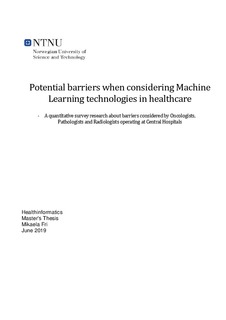| dc.description.abstract | Artificial Intelligence (AI) is arising across many disciplines worldwide and is expected to rapidly grow in the coming years. AI is said to have great contribution to improvements of the operational efficiency and the delivery of care for patients as well as the accessibility of healthcare services for people. Therefore, such technology is said to have remarkable impact on the dilemma of aging population and the increasing lack of healthcare workers. These are essential aspects an organization like healthcare should aim to benefit from when considering implementing AI technologies into its organization. Such technology can manage a range of different tasks, from managing the supply chain to giving diagnostic support. A Machine Learning (ML) algorithm is able to process and analyse huge amounts of information, such as clinical notes, health records and diagnostic images and find insights and patterns in a much shorter time than human performed.
The aim for this thesis is to identify the possible barriers when considering implementing AI and ML technologies into clinical settings according to clinicians working within oncology, pathology and radiology. This work utilizes a literature review for collecting knowledge about how these technologies are currently being applied in the field and potential challenges as well as barriers a healthcare organization might face when considering such implementation. The second approach utilized in this thesis is a quantitative methodology consisting of structured interviews to identify potential barriers according to Oncologists, Pathologists and Radiologists operating at Central Hospitals in Finland.
The results from this thesis imply that AI and ML can support high quality, efficient and accurate diagnostics, but are still some steps away from implementation and further research within some topics is recommended. These topics are for instance evidence of achieved efficiency, quality and cost benefits of utilizing AI and ML technology within diagnostics as well as scientific proof of its realized benefits and values achieved within diagnostics. Other areas that can be considered as barriers are the pursued current state of regulation and ethical guidelines regarding in what extend such technology is accepted to be utilized within the workflows for clinicians. Furthermore, the results show that it could be implicated as a barrier if there would be suggestions about AI and ML technology making diagnostical decisions for clinicians without human input. | |
